
Francisco Franco Bahamonde was a Spanish military general who led the Nationalist forces in overthrowing the Second Spanish Republic during the Spanish Civil War and thereafter ruled over Spain from 1939 to 1975 as a dictator, assuming the title Caudillo. This period in Spanish history, from the Nationalist victory to Franco's death, is commonly known as Francoist Spain or as the Francoist dictatorship.

The Prado Museum, officially known as Museo Nacional del Prado, is the main Spanish national art museum, located in central Madrid. It is widely considered to house one of the world's finest collections of European art, dating from the 12th century to the early 20th century, based on the former Spanish royal collection, and the single best collection of Spanish art. Founded as a museum of paintings and sculpture in 1819, it also contains important collections of other types of works. The Prado Museum is one of the most visited sites in the world and is considered one of the greatest art museums in the world. The numerous works by Francisco Goya, the single most extensively represented artist, as well as by Hieronymus Bosch, El Greco, Peter Paul Rubens, Titian, and Diego Velázquez, are some of the highlights of the collection. Velázquez and his keen eye and sensibility were also responsible for bringing much of the museum's fine collection of Italian masters to Spain, now one of the largest outside Italy.

Francoist Spain, or the Francoist dictatorship, was the period of Spanish history between 1939 and 1975, when Francisco Franco ruled Spain after the Spanish Civil War with the title Caudillo. After his death in 1975, Spain transitioned into a democracy. During this time period, Spain was officially known as the Spanish State.

The Congress of Deputies is the lower house of the Cortes Generales, Spain's legislative branch, the upper house being the Senate. The Congress meets in the Palace of the Parliament in Madrid.
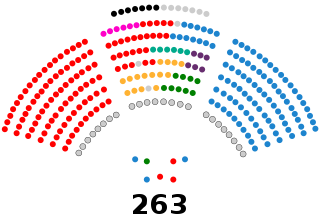
The Cortes Generales are the bicameral legislative chambers of Spain, consisting of the Congress of Deputies, and the Senate.
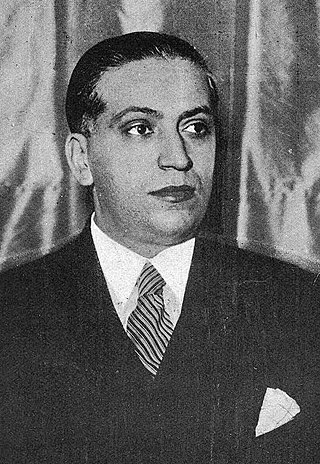
José Calvo Sotelo, 1st Duke of Calvo Sotelo, GE was a Spanish jurist and politician, minister of Finance during the dictatorship of Miguel Primo de Rivera and a leading figure during the Second Republic. During this period he became an important part of Renovación Española, a monarchist movement. His assassination in July 1936 by the bodyguard of Socialist party leader Indalecio Prieto was an immediate prelude to the triggering of the military coup plotted since February 1936, the partial failure of which marked the beginning of the Spanish Civil War.

The 1977 Spanish general election was held on Wednesday, 15 June 1977, to elect the Spanish Cortes of the Kingdom of Spain. All 350 seats in the Congress of Deputies were up for election, as well as all 207 seats in the Senate.
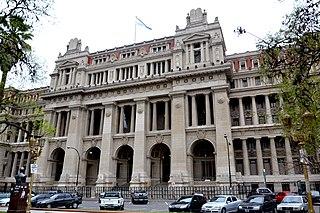
The Supreme Court of Argentina, officially known as the Supreme Court of Justice of the Argentine Nation, is the highest court of law of the Argentine Republic. It was inaugurated on 15 January 1863. However, during much of the 20th century, the Court and the Argentine judicial system in general, lacked autonomy from the executive power. The Court was reformed in 2003 by the decree 222/03.

Centro is a district of Madrid, Spain. It is approximately 5.23 km2 in size. It has a population of 149,718 people and a population density of 28,587/km2. It roughly corresponds to the bulk of the housing formerly enclosed by the so-called Walls of Philip IV. The district is made up of the neighbourhoods of Cortes, Embajadores, Justicia, Universidad, Palacio and Sol.
Madrid, the capital of Spain, is divided into 21 districts, which are further subdivided into 131 administrative wards. Additional neighborhoods exist outside the boundaries of administrative borders. Each district is governed by a body named Junta Municipal de Distrito. Residents of Madrid are typically called Madrileños.

Gran Vía is a station on Line 1 and Line 5 of the Madrid Metro, located underneath Gran Vía and Red de San Luis Plaza in the Centro district of Madrid. It is located in fare zone A.

The Ateneo de Madrid is a private cultural institution located in the capital of Spain that was founded in 1835. Its full name is Ateneo Científico, Literario y Artístico de Madrid.
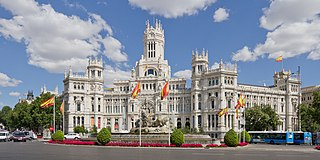
Cibeles Palace, formally known as Palacio de Comunicaciones and Palacio de Telecomunicaciones until 2011, is a complex composed of two buildings with white facades and is located in one of the historical centres of Madrid, Spain. Formerly the city's main post office and telegraph and telephone headquarters, it is now occupied by Madrid City Council, serving as the city hall, and the public cultural centre CentroCentro.

Madrid is the capital and most populous city of Spain. The city has almost 3.6 million inhabitants and a metropolitan area population of approximately 6.7 million. It is the second-largest city in the European Union (EU), and its monocentric metropolitan area is the second-largest in the EU. The municipality covers 604.3 km2 (233.3 sq mi) geographical area.
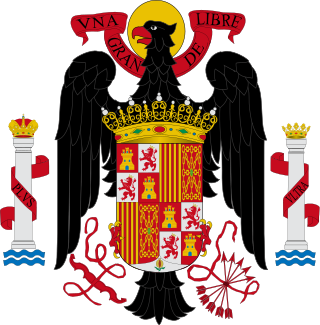
The Law of Succession to the Headship of the State was the fifth of the eight Fundamental Laws of the Realm organizing the powers of the Francoist regime in Spain. It established provisions for the restoration of the Spanish monarchy, appointed Francisco Franco as the Head of State of Spain for life. It provided that his successor would be proposed by Franco himself with the title of King or Regent of the Kingdom, but that would have to be approved by the Cortes Españolas.

María Romilda Servini de Cubría is an Argentine lawyer and judge who presides over Federal Court No. 1 of Buenos Aires.

La Ingobernable is a series of self-managed social centres in central Madrid, Spain. The squats have been used by feminist, environmentalists, LGBTI, anti-racist and other cultural groups. Between 2017 and 2019, the La Ingobernable was based in a municipal building located at the corner of Paseo del Prado and Calle del Gobernador. It was then located at Calle Alberto Bosch 4, behind the Prado Museum from March until April 2020, when it was evicted during the state of alarm. In 2021, an Office for Social Rights was set up at Calle Cruz 5.
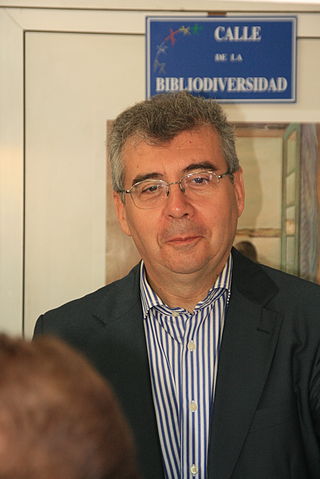
Pedro Montoliú Camps is a Spanish journalist who was named a Chronicler of the Villa de Madrid in 1999.
Spanish Parliamentarism is a tradition of political representation, legislative activity and governmental control —or parliamentary control of the government— that dates back to the medieval Cortes and the Ancien Régime, in a manner equivalent to the parliamentarism of other Western European nation-states.



















